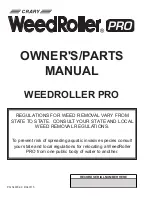
WCB11070 (PDF FORMAT)
7
©
Copyright Eaton Corp. 2007, All Rights reserved.
2.3.4
All pipes should be free of metal chips, cutting com-
pound and any other foreign matter. Pipe ends should
be reamed after cutting to eliminate possible restric-
tions. For optimum air system response, a minimum
number of bends and elbows should be used.
2.3.5
The WCB2 tensioner does not require lubricated air;
however associated control valves may. Consult the
valve manufacturer for appropriate recommendations.
2.4
Coolant System
Make sure that the water inlets and outlets are
positioned as close as possible to the 6
o'clock and 12 o'clock positions, respectively.
This will help to minimize the formation of air
pockets in the water cavity during operation,
which could contribute to overheating of the
tensioner.
2.4.1
Maximum allowable coolant pressure within the water
cavity is 40psi for size 36 and 48 WCB2 units and
45psi for all other sizes. See Table 7 for coolant pres-
sure limitations as measured at the inlets and outlets
of water jackets. Note that inlet pressures exceeding
the maximum allowable static pressures are only per-
missible under dynamic flow conditions, provided that
the average pressure between the inlet and outlet
does not exceed the maximum allowable pressure
stated above. The use of an accumulator or pressure
relief valve may be desirable to reduce the effect of
pressure spikes in the coolant system during opera-
tion.
High outlet pressures or surges exceeding
maximum allowable may result in damage to
the tensioner.
Maximum allowable water pressure is depen-
dent upon tensioner size and specific applica-
tion requirements.
Inlet pressures exceeding the maximum
allowable average pressure are only permissi-
ble when the outlet pressures are at or below
the limits listed in Table 7.
2.4.2
The coolant supply and discharge hose, pipe and fit-
ting sizes, along with minimum flow rates for the ten-
sioner rated horsepower, are listed in Table 6.
2.4.3
Coolant supply connections to the tensioner should
provide a parallel flow through each section of the ten-
sioner. Series flow is not recommended, as it can lead
to overheating of the tensioner.
2.4.4
Inlet and outlet coolant manifolds must be provided.
Manifolds should be constructed to allow for even flow
through all ports. On sizes 18" and larger, two hoses
can be routed to the reaction plates (30) to assist with
balancing the flow to each wear plate.
Note :
Reaction plates (30) in WCB2 sizes 18" and
larger typically have two inlet and two outlet ports to
assist with obtaining balanced flow to each cooling
chamber. In the event that a multiple disc tensioner
includes an older style reaction plate with only one
inlet and one outlet port, water flow should be
restricted at the inlets to the pressure plate (13) and
mounting flange (1) to allow for equally proportional
heat dissipation at each cooling cavity. See
Figure 5
2.4.5
Use flexible connecting hose to each tensioner cool-
ant section to allow axial travel of the pressure plate,
reaction plate, and end plate during tensioner opera-
tion without restricting the movement of components.
When determining hose lengths, consideration should
be given to movement and location of the pressure
plate and reaction plate as friction material wears.
Hose lengths running between the manifolds and the
inlet or outlet ports should be equal in length, if possi-
ble. Reductions in the recommended line diameter
should be avoided to prevent excessive line pres-
sures.











































